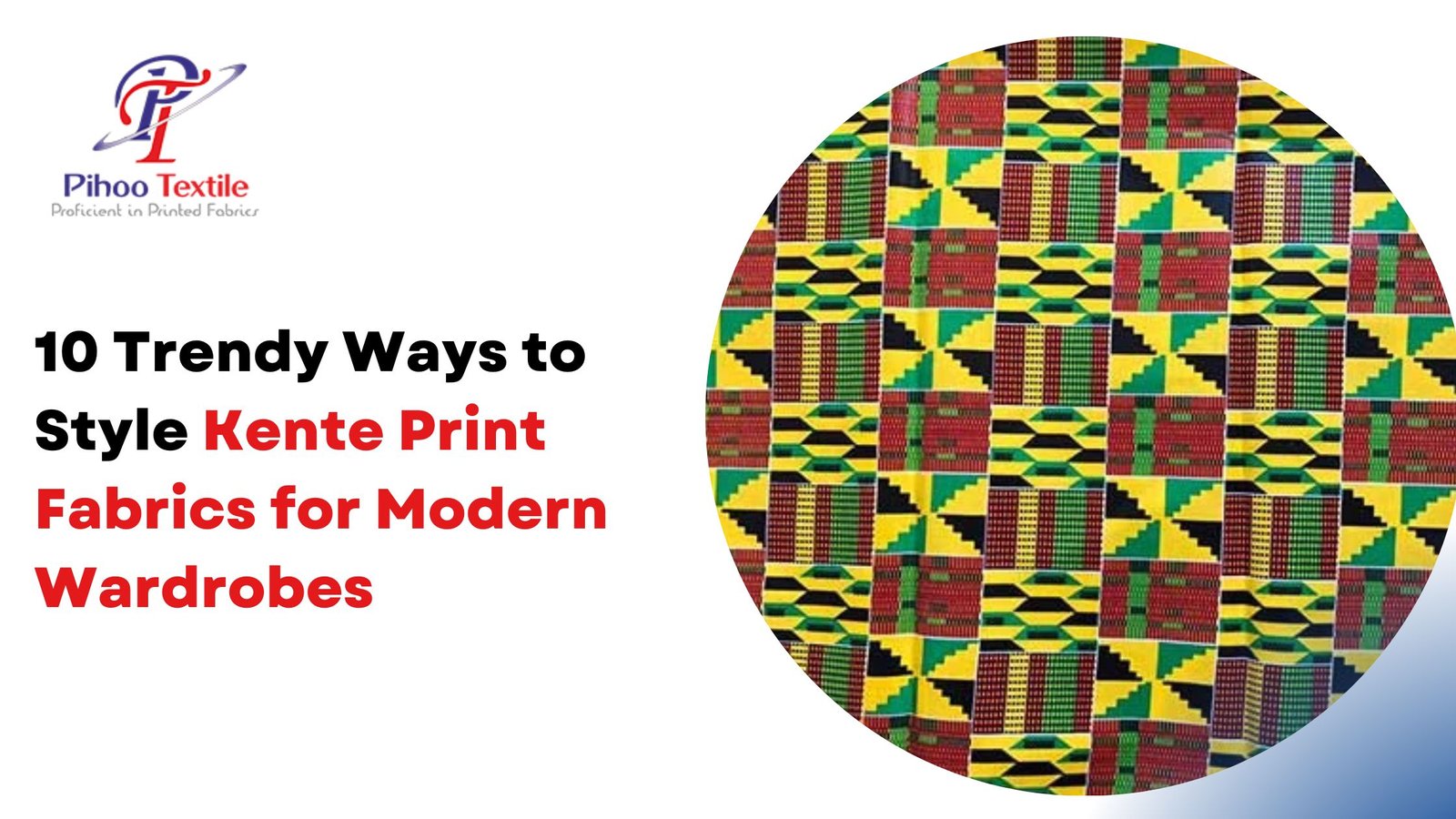10 Trendy Ways to Style Kente Print Fabrics for Modern Wardrobes
Introduction
Kente fabric sits in closets unworn because people treat it as ceremonial-only clothing. The vibrant strips and geometric patterns feel too formal for daily life. This wastes one of the most versatile textiles in existence. Kente works beautifully in modern wardrobes when styled intentionally—from casual streetwear to professional settings.
This guide presents ten practical ways to integrate Kente into everyday outfits, covering dresses, suits, accessories, and layering strategies that balance cultural heritage with contemporary fashion sensibilities.
Kente Blazers for Professional Settings
A tailored Kente blazer transforms standard office wear immediately. Pair with solid black trousers and a white blouse for corporate environments that allow personal expression.
The structured silhouette of blazers contains Kente’s visual intensity. The jacket becomes a statement piece while the rest of the outfit provides visual rest. This balance reads professional rather than costumey.
Choose smaller-scale Kente patterns for conservative workplaces. Larger, bolder strips work better in creative industries or casual Fridays. Fit matters more than pattern—an ill-fitting Kente blazer loses impact regardless of print quality.
Modern Kente Dresses
Kente dresses range from full ceremonial gowns to contemporary midi silhouettes. Fit-and-flare designs work for weddings and formal events, while simpler A-line or sheath cuts handle everyday wear.
The key is choosing appropriate scale for context. Large-scale Kente strips create dramatic floor-length gowns. Smaller repeating patterns suit knee-length or midi dresses for less formal settings.
Belt placement defines proportion in Kente dresses. The fabric’s horizontal strips can make torsos appear wider. A belt at the natural waist breaks up the visual line and creates a flattering definition.
Kente Two-Piece Sets
Matching crop tops and high-waisted skirts or pants deliver complete outfits without styling decisions. The coordinated nature of two-piece sets handles Kente’s visual density better than separates.
These sets work particularly well for festivals, cultural celebrations, or summer events where bold dressing feels appropriate. The crop-and-skirt combination shows skin while maintaining coverage, balancing contemporary and traditional sensibilities.
Choose fitted silhouettes rather than oversized versions. Kente’s patterns already provide visual weight—loose, baggy cuts add unnecessary bulk.
Kente Bomber Jackets
Here’s an uncomfortable truth: most people own Kente they never wear. A bomber jacket solves this by making Kente instantly casual.
Throw a Kente bomber over jeans and a plain t-shirt. The jacket becomes the focal point while everything else stays neutral and comfortable. This works for weekend errands, coffee shops, or casual social gatherings.
The fitted silhouette of bombers flatters more body types than loose cardigans or kimonos. It provides structure while the Kente pattern adds personality without requiring full traditional commitment.
Tailored Kente Trousers
Kente pants—whether wide-leg palazzo style or fitted cigarette cut—pair beautifully with solid-colored tops. The trousers provide pattern punch while the top offers simplicity.
High-waisted cuts work best. They define the waist and allow clean tucking of tops, maintaining proportions rather than creating bulk at the midsection.
For professional settings, choose straight-leg or slightly tapered cuts in darker Kente colorways. Weekend wear can handle wider legs and brighter patterns. Match with simple flats or ankle boots to keep focus on the fabric.
Kente Button-Down Shirts
Kente shirts work for both men and women when styled with intention. Men can pair with chinos or dark denim and leather shoes for smart-casual looks. Women can tuck into pencil skirts or wear loosely over fitted jeans.
The button-down structure contains Kente’s visual intensity. Unlike flowing garments that drape and shift, the crisp lines of collared shirts create clean edges that frame the pattern.
Roll sleeves to three-quarter length for casual styling. Keep cuffs buttoned and add a watch for more formal contexts. The same shirt reads differently based on minor styling adjustments.
Kente Accessories for Subtle Impact
Accessories offer the lowest-risk entry point for Kente styling. Scarves, headwraps, clutches, and small bags introduce patterns without overwhelming outfits.
A Kente headwrap transforms a basic jeans-and-tee combination into an intentional look. The wrap draws attention upward toward the face while keeping the body neutral.
Kente clutches work particularly well with all-black or monochrome outfits. The bag becomes a controlled pop of color and pattern that feels curated rather than accidental.
Mixing Kente With Denim
Denim grounds Kente’s formality and makes it accessible for everyday wear. A Kente top with dark-wash jeans balances traditional textile with Western casualwear.
Distressed denim works surprisingly well with Kente. The juxtaposition of refined weaving against deliberately worn denim creates visual interest through contrast rather than coordination.
Add structured shoes—loafers, booties, or clean sneakers—to prevent the look from skewing too casual. The footwear choice determines whether the outfit reads as intentional style or thrown-together randomness.
Kente Shorts for Warm Weather
Kente shorts paired with basic tanks or crop tops work for summer outings. The shorts provide the pattern while the top maintains simplicity.
High-waisted cuts flatter more body types and allow for tucking tops cleanly. This keeps the silhouette defined rather than appearing shapeless.
Balance is critical. If wearing fitted shorts, choose a slightly looser top. Skin-tight shorts with a bodycon crop creates visual tension rather than harmony.
Statement Kente Outerwear
Kente kimonos and long cardigans function as instant outfit elevators. Layer over simple dresses, jeans and tanks, or even athleisure for bohemian-inspired looks.
The flowing silhouette adds movement and dimension to static outfits. This creates interest through shape rather than requiring multiple printed pieces.
Kente outerwear also solves transitional weather challenges. Light coverage for cool mornings without the bulk of structured jackets. Roll up sleeves or push back shoulders to adjust formality on the go.
Common Styling Mistakes
Over-accessorizing with busy Kente prints creates visual chaos. When wearing large-scale patterns, choose simple jewelry and shoes. Let the fabric be the accessory.
Mixing too many Kente patterns without color coordination overwhelms outfits. If combining multiple pieces, ensure they share common colors to create visual connection. Random mixing rarely succeeds even for experienced stylists.
Ignoring the cultural weight of certain Kente designs causes problems. Some patterns traditionally signify royalty or specific ceremonies. Wearing these casually can appear disrespectful in cultural contexts. Research pattern meanings when possible.
FAQs
Q: Can I wear Kente casually or is it only for special occasions?
A: Kente works for daily wear with appropriate styling. Traditional full wraps suit ceremonies, but modern adaptations like blazers, pants, and accessories translate perfectly to casual contexts. The key is scaling down—choose smaller pattern repeats and pair with contemporary silhouettes rather than ceremonial draping styles.
Q: How do I choose the right Kente colors for my skin tone?
A: Traditional Kente wearing prioritizes cultural and social messaging over skin tone matching. However, modern styling can consider color theory—warm undertones often suit gold, red, and orange-based Kente, while cool undertones pair well with blue, green, and purple patterns. Personal confidence matters more than rigid matching rules.
Q: Should I mix Kente with other African prints?
A: Mixing works when colors coordinate. Pull one common color from both fabrics to create visual connection. Also vary scale—pair large Kente strips with smaller-scale Ankara prints. Mixing two large-scale bold patterns rarely succeeds unless you’re highly experienced with print combination.
Q: Is synthetic Kente as good as traditional silk-cotton blend?
A: Synthetic versions cost less but lack the texture, drape, and cultural authenticity of traditional Kente. Silk-cotton blends breathe better, hold dye vibrancy longer, and carry appropriate weight for structured garments. Synthetic Kente often looks shiny and cheap in natural lighting, undermining the styling effort.
Q: How much Kente is too much in one outfit?
A: Generally limit Kente to one statement piece per outfit. Kente pants with a solid top works. A Kente dress stands alone. Wearing Kente top, bottom, and accessories simultaneously overwhelms most looks. Exception: coordinated two-piece sets designed to be worn together create intentional cohesion rather than accidental overload.
Q: Can men and women style Kente the same way?
A: Core principles apply universally—balance bold patterns with neutral basics, ensure proper fit, limit print to one statement piece. Men incorporate Kente through shirts, jackets, shorts, or trousers with solid tees or button-downs. Women have more silhouette options including dresses and skirts. Gender matters less than proportion and restraint.
Conclusion
Kente transforms from ceremonial textile to wardrobe staple through intentional styling. Balance bold strips with neutral basics. Prioritize fit over pattern. Choose contemporary silhouettes that honor tradition without requiring full ceremonial commitment. Most importantly, wear Kente regularly rather than preserving it for events that may never arrive.
Select one styling approach from this list. Build confidence through repetition.
Pihoo Textile stocks authentic Kente fabrics woven with traditional silk-cotton blends, not synthetic shortcuts. Our collection includes both ceremonial-weight Kente for special occasions and lighter-weight versions designed specifically for everyday garment construction.
We source from artisan cooperatives that maintain traditional weaving techniques while creating contemporary colorways suited to modern fashion. Each piece features the characteristic hand-woven strips sewn edge to edge—the hallmark of authentic Kente construction.
Visit pihootextile.com to explore Kente fabrics organized by color intensity, pattern scale, and weight. Find authentic textiles that honor cultural heritage while fitting seamlessly into contemporary wardrobes. Build outfits that celebrate tradition through daily wear, not archived preservation.


